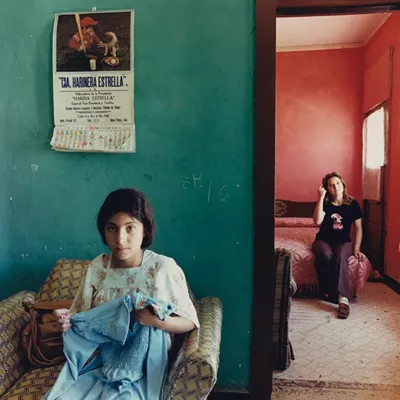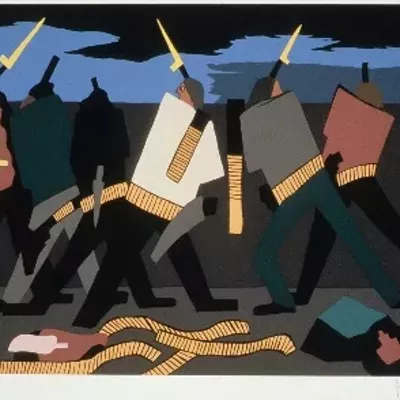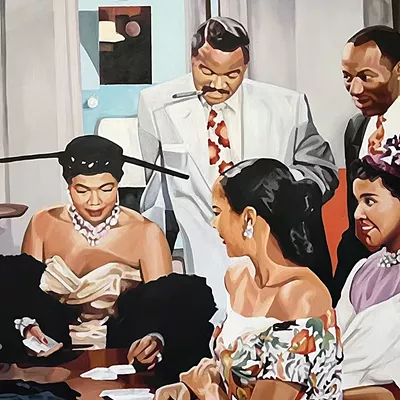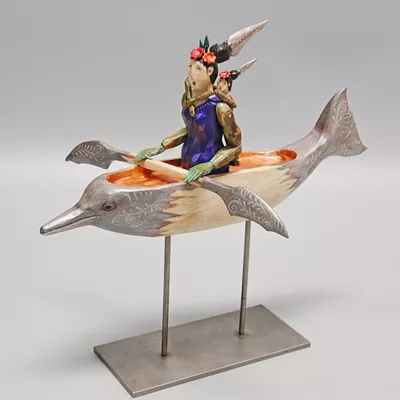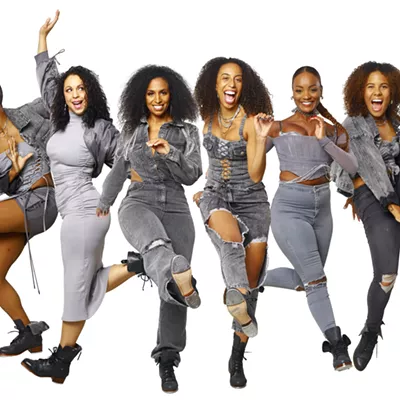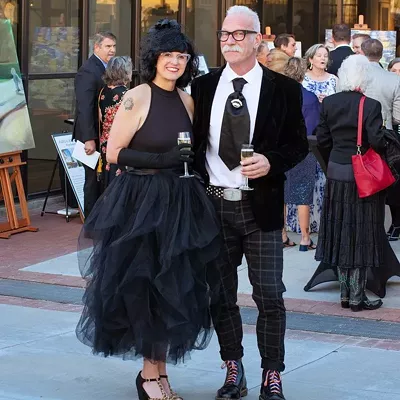Five years ago, artist Lauri Marks Kaye was drawing outside in a downtown café when a man covered with tattoos wandered over to chat.
Turned out the man had just gotten out of jail. He sat down and told her not only about his arty tattoos, but about his complicated life story in prison and elsewhere. Kaye raced to write his words down, and capture him in photos.
Hearing his tales "changed my life," the artist says. It also changed her art. Ever since that day—COVID times excepted—she has haunted coffee shops in search of other strangers with stories to stories and a willingness to be photographed or have their portraits drawn.
Kaye turns these simple images into elaborate mixed-media works. She puts them into her computer to color them in gleaming green and yellow and gets a "guy downtown with a laser machine" to print them on metal. The final pieces are joyously expressionist, an appealing mix of line drawing and fields of color.
The artist also likes to make landscapes. Though some of her works picture iconic Tucson sites like Mission San Xavier and Sabino Canyon, she prefers places off the beaten track.
The Tucson Portrait Series, as she calls it, "illuminate people, places and events that make Tucson extraordinary."
Five years in, she has completed some 50 of the pieces. Between this Friday, Nov. 27, and Sunday, Dec. 6, anyone in Tucson—or anywhere in the world, for that matter—can see her Tucson portraits virtually.
Courtesy of the first-ever Open Studio Tours Online run by the Arts Foundation this year, art lovers can peruse artworks by about 50 Southern Arizona artists via their computers.
For 10 years, the Arts Foundation ran an annual in-person artist studio tour. In those halcyon days, art fans traveled all around town to visit actual studios filled with paints and brushes and clay, meet the artists in person, and take a gander at the artworks.
COVID-19 has changed all that. Now the tour is entirely virtual.
"It's a brand-new way of doing this," says Laura Reese, spokeswoman for the Arts Foundation. "Everything is new and we're still learning."
Participating artists have created their own pages on the studio tours' online site, posted images of their artwork and written brief artists' statements. Their pages also have plenty of links, to their own web sites, their contact information and, importantly, instructions on how to buy their art. (The Arts Foundation doesn't participate in sales.)
A few brave souls will be giving live Zoom talks and lead their viewers on a virtual tour of their studios. The half-hour Zoom tours will be mostly on the first weekend.
The artists don't have to pay any fees to be on the tour, a welcome break at a time when many have lost income.
"Our hope was to make this as accessible as possible," Reese says.
The Arts Foundation even offered two free workshops, one giving artists tips
for photographing their artworks, and the other for marketing the work. With Christmas right around the corner, "We hope the tours trigger sales," Reese says.
The artists who opted in have created all kinds of art; their genres range from painting, ceramics and jewelry to photography, printmaking and sculpture.
Fewer artists than usual have signed up; this year's 50 artists are only one-third of last year's tally of 150. The tour might have lost some artists intimidated by the tech requirements, but, Reese says, they picked up some first-timers who in the past didn't feel comfortable welcoming strangers into their home studios.
James Larson is one artist who embraced and chose to Zoom.
"My passion is creating large, colorful one- of-a-kind oil paintings," he says, like "Pink Lily" a brilliantly colored piece on his tour page. His virtual Zoom tour will be at 11:30 a.m., this Saturday, Nov. 28. (See his page on the website to get the Zoom link.)
"It will be a 30-minute tour, and I'll show my studio and my work," he says. He admits to getting some help with tech from his grown son. But he wasn't frazzled by it. "It's the future," he says cheerfully.
Mel "Melo" Dominguez, a respected Tucson muralist, is also doing a live Zoom tour, which provides an opportunity for the artist to once again connect with fans. Normally Dominguez works in collaboration with other people, but the coronavirus put a stop to that.
As they write in their artist statement, "pre-COVID, my mural process included community involvement from concept to actually painting the mural together..." (Their half-hour Zoom will be at 11 a.m. this Saturday, Nov. 28.)
Dominguez's whimsical murals celebrate Chicano/Chicana culture. One of their Tucson works pictures the Virgin of Guadalupe, low-rider cars, folklórico dancers and mariachi musicians. But other pieces deal with political and social issues and environmental problems.
Painter Howard Kline, who pivots from abstract expressionism to classic figurative works, is staying away from Zoom. He's loved having the in-person tours at his home and studio.
"I usually get 50 to 100 people," he says. But he's game to try out this year's viral tour.
As a teenager living off the coast of Massachusetts, Kline became both lobster fisherman and an artist. His paintings of the sea, the boats and fisherman got him a scholarship to an art school in Boston. Ever since, for more than 50 years, he's been able to make a living as a painter.
The late Tucson artist Maurice Grossman, who died long before Kline arrived in Tucson, has surprisingly had an impact on Kline. The two never met, but when Kline and his wife moved to town they bought the beloved artist's house and adjoining studio.
Kline hears endless stories of Grossman's joie de vivre and dedication to art. And he keeps a photo of Grossman on his studio wall and a Grossman sculpture across the room. Both are the source of joyful inspiration.

